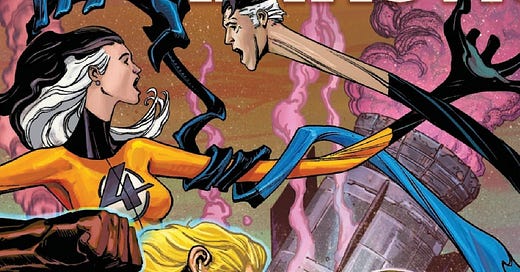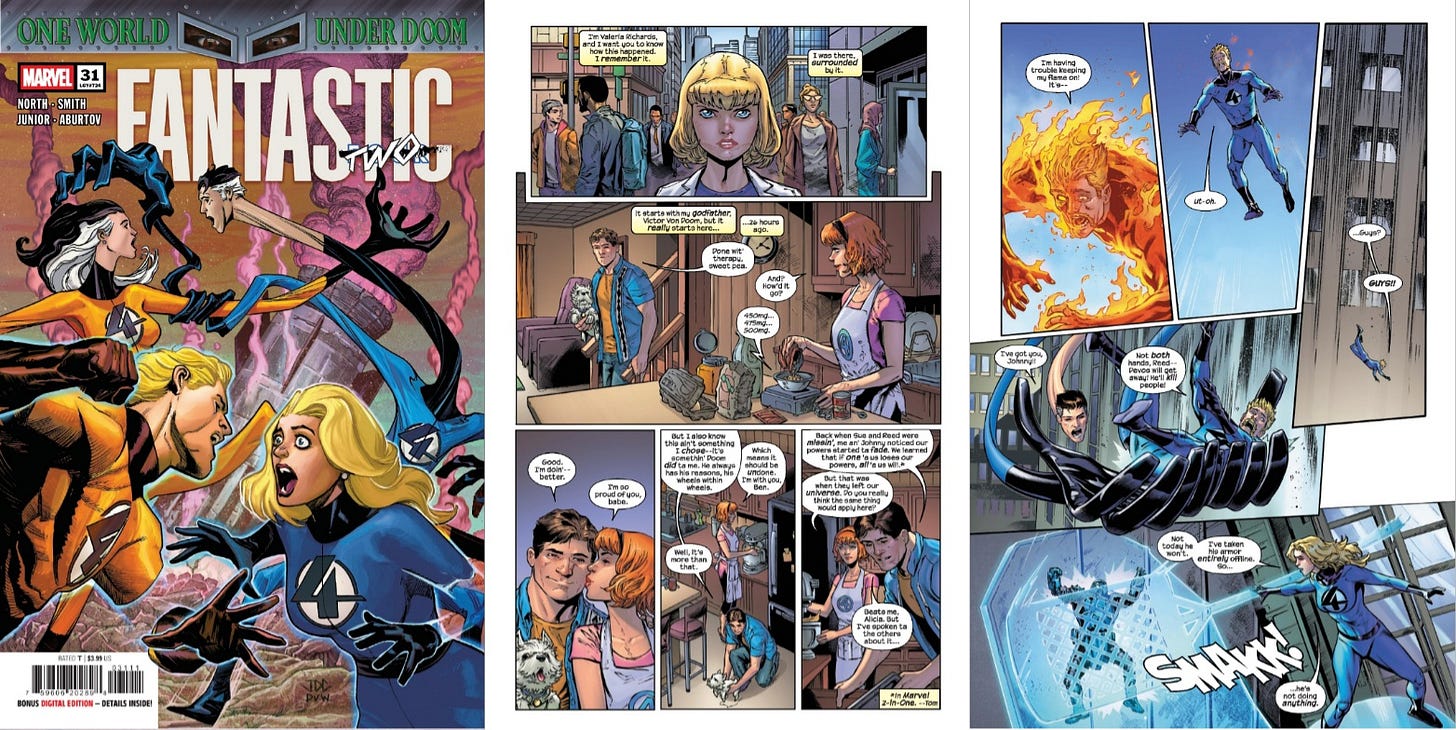“The Fantastic Two”
Writer: Ryan North
Art: Cory Smith
Inks: Oren Junior
Colors: Jesus Aburtov
Letters: VC’s Joe Caramagna
Cover: Joshua Cassara & Dean White
Variant Covers: Chris Giarrusso; Claudio Sciarrone; Sean “Cheeks” Galloway
Publisher: Marvel Comics
Price: 3.99
Release Date: April 30, 2025
A Team Problem Now
The Fantastic Four’s involvement in One World Under Doom seemed predictable: the team would take point in the larger battle against their long-time nemesis. But North defied expectations, sidelining the team first as a result of Ben’s transformation in One World Under Doom #2 and now even more so thanks to an expanded danger to the whole team in Fantastic Four #31.
Ben’s struggle to come to terms with the loss of his power takes on a whole new dimension in Fantastic Four #31. As a result of Ben being transformed into a normal human, the rest of the team’s powers are beginning to fade as well. Exposure to cosmic rays is Ben’s best hope to transform back. Unfortunately it can’t be just any cosmic rays. Only the original blast can do the trick. But helping Ben might mean putting all of time at risk.
Fantastic Four #31 undercutting some of the previous issue’s emotional resonance. The narrative power behind Ben’s transformation back into an ordinary human was in how he faced it. No matter the support other characters provided, the problem was solely Ben’s to decide how to deal with. North turned in a strong exploration of the character in Fantastic Four #30. But here North turns one character’s very emotional struggle into more of a team oriented procedural story.
This isn’t to say that Fantastic Four #31 has lost the plot completely when it comes to Ben’s story. North begins the issue with him, and the unexpected development on the final page is a heartbreaking consequence of Ben’s emotional struggle. These bookends actually further the tragedy of the overall situation and preserves some of the previous issue’s emotional power.
Valeria works well as Fantastic Four #31’s viewpoint character. Using her to recount events rather than having a member of the team narrate in some fashion leaves the reader with only art and dialogue to tell them what is going on in the characters’ mind. Valeria’s recounting becomes more direct late in the issue, but for the most part North has designed a “show don’t tell” adventure. It’s a compelling way to experience this story.
Subtle Expressions
The visual heart of Fantastic Four #31 is the appearance of the characters as they interact with each other. They run through a variety of emotional states–positive early in the issue before growing progressively less optimistic as it goes on. The best example of the former is the dinner table sequence. Smith delivers closeups on almost every member of the family as they brainstorm how to get their powers back. From panel to panel Smith works through different expressions, some with subtle changes such as Reed who is center to most of the panels in this sequence, and others with broader changes as multiple panels pass between their appearances.
Smith brings a high level of detail to characters overall and their faces in particular. He uses groups of tiny lines to create small patches of shading that define characters’ cheekbones, jawlines, and so forth. This technique allows Smith to achieve the more subtle variations in expression that are seen throughout the issue.
Late in the issue, as Ben’s plight (and therefore the team’s) grows more desperate, Smith’s shading technique again allows him to track subtle changes as the characters’ expressions descend toward worry and even pessimism. This is most evident with Ben whose emotions swing somewhat like a pendulum. North gives the character almost no dialogue in the issue’s final pages, so it’s mostly up to Smith to convey to the reader what the character is going through.
These more subtle patches of lines stand in contrast to the heavier lines and shading that are helped along with Junior’s inking. Thicker lines and darker patches add weight to items like clothes and background objects. Ultimately the characters stand out because of their relative softness.
Aburtov’s color palette for the series has always favored brighter tones. But it’s always well balanced and seldom upstages the art, especially on Earth. Space settings are sometimes the exception to that, and in Fantastic Four #31, the coloring gets multiple opportunities to steal the show. The issue’s final pages take place in space. Objects and phenomena in the space sequences pop off the page thanks to their contrast with the black background. The cosmic rays, though, are another matter altogether. They appear like a green rainstorm in space and Aburtov makes sure they overwhelm everything on the page. Deliberately or not, this further underscores their importance as Ben’s only hope.
Caramagna’s strength in Fantastic Four has always been his organizational skill. This doesn’t sound like much, but in a series that often delivers issues with text heavy sequences it adds a lot to the visual presentation. This is again the case in Fantastic Four #31. Somewhat uncharacteristically, though, there are several instances of sound effects. They are mostly present during the cosmic ray sequences. Caramagna’s placement of them reinforces the rain-like quality that the artists give the rays.
Final Thoughts
Fantastic Four almost has to be graded on a curve because so few issues in North’s run have missed the target–and none of them seriously. Fantastic Four #31 doesn’t have quite the same emotional heft that the previous issue did. Ben’s emotional journey, while not ignored, does take a backseat to the team’s problem for much of the issue. That said, Fantastic Four #31 is another strong entry in the series and a particularly noteworthy issue in the One World Under Doom event.
What is good, everybody?
Thanks for reading the review of Marvel Comics’ Fantastic Four #31.
If you enjoyed this review (or even hated it!)…
You can also find me on X and Bluesky where I’m very active.
Republished at Comic Watch.





